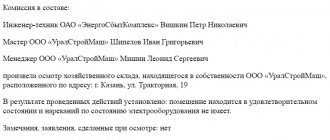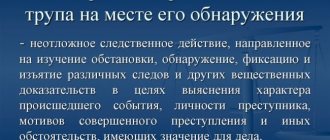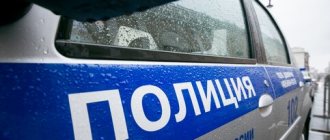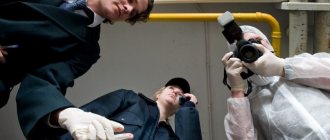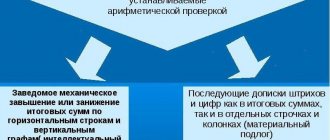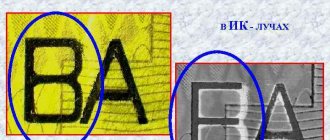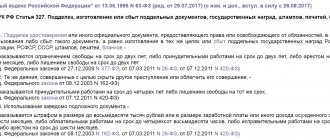1. Inspection and certification reports are drawn up in compliance with the requirements of this article, articles 166 and 167 of this Code.
2. The protocols describe all the actions of the investigator, as well as everything discovered during the inspection and (or) examination in the sequence in which the inspection and examination were carried out, and in the form in which what was discovered was observed at the time of the inspection and examination. The protocols list and describe all items seized during inspection and (or) examination.
3. The protocols must also indicate at what time, in what weather and what lighting the inspection or examination was carried out, what technical means were used and what results were obtained, what objects were seized and sealed and with what seal, where after the inspection the corpse or objects were sent relevant to the criminal case.
Inspection of items
In accordance with the law (Article 177 of the Code of Criminal Procedure of the Russian Federation), objects discovered during an inspection of the scene of an incident, area and premises, during a search, are examined at the place where these investigative actions are carried out.
The results of the inspection are recorded in the protocol. If the inspection of objects requires a long time or there are other reasons (for example, if the object is presented to witnesses at the place of interrogation), the investigator carries out an inspection at the place of investigation. In this case, the inspection constitutes the content of an independent investigative action. Most often, it is advisable to repeat the inspection of individual items in the investigator’s office, regardless of whether they were examined at the place where they were found or not.
The examination of objects must be carried out in such a way that those signs and properties that are essential to the case do not escape the investigator’s attention.
The procedure for inspecting items:
- studying their general appearance (the condition of the item, its name and purpose, if necessary, the rules for using these items);
- individual characteristics of the object, its defects and features are identified;
- signs are identified indicating for what purpose it was used and how intensively;
- signs are identified that indicate a connection between the inspected object and the event under investigation.
All this data is recorded in an inspection report, to which photographs can be attached.
Inspection of objects cannot replace their expert examination. With this in mind, the investigator during the inspection must:
- concentrate your efforts on identifying those traces and signs that will subsequently become the objects of expert research;
- strictly adhere to the rules for handling inspected items, guaranteeing their safety and evidentiary value.
Topic 10. Characteristics of investigative actions.
Legal basis for inspection: Art.
146, 164-170, 176-178, 180, 284, 287 Code of Criminal Procedure. An inspection is an investigative action consisting of a personal, direct examination by an investigator or interrogator using various senses of certain material objects in order to detect traces of a crime (material), clarify other circumstances relevant to the criminal case, and procedurally consolidate the information received.
The inspection is aimed at obtaining 2 types of evidence: the inspection report and physical evidence.
The inspection is adapted to work with material traces of crimes.
Material traces of a crime are:
1) in a narrow sense - a materially fixed display of any objects on other objects as a result of mechanical action; traces of chemical influence on the object, as well as physical influence of another type (thermal, light, etc.) that took place during the commission of the crime.
2) in the broad sense of the word - any material changes that have occurred in any place.
Other circumstances relevant to the case are the environment of the inspection place, which has independent evidentiary value.
Types of inspection purposes:
1) detection and recording of material traces of a crime;
2) identifying the situation at the inspection site (most often, the scene of the incident);
3) obtaining samples for comparative research;
4) other goals (for example, identifying the life conditions of raising a minor).
The basis for the inspection depends on the object of inspection.
The objects of inspection according to the Code of Criminal Procedure may be the scene of the incident; a place or premises that is not the scene of the incident; objects and documents; dead body.
The basis for inspecting the scene of an incident, area, premises is the availability of information about a crime committed there or a change in the situation associated with it, as well as about the significance of the situation on the area or premises in order to establish circumstances relevant to the case.
The basis for examining objects and documents, as well as corpses, is the presence of information about the possible presence of traces of a crime on objects and documents, a corpse, which is a sign of material evidence.
For inspections of the crime scene and examination of the corpse, it is possible to conduct them before the initiation of the main case; and in this case, the basis for their proceedings is supplemented with information about the existence of an urgent case. In addition, inspection of a premises that is a dwelling is possible only with the consent of the owners of the dwelling. In the absence of consent, it is necessary to justify the availability of urgent information. In addition, if the examination of the corpse is preceded by exhumation (removal from burial places), it is necessary to issue a Resolution on the exhumation and examination of the corpse; This resolution contains information about the consent of close relatives of the corpse. If there is no consent, you must apply to the court with a request to exhume and examine the corpse, where it is necessary to state the justification.
Types of inspection according to the Code of Criminal Procedure are usually distinguished according to the object of inspection:
1. inspection of the scene of the incident;
The scene of an incident is generally understood to mean not only the place where the crime was committed, but also any area of the area or premises where material changes caused by the crime are located.
2. inspection of the premises;
3. inspection of the area;
These inspections (2 and 3) are so called when the locations are not the scene of the incident (eg to evaluate witness statements).
4. inspection of objects;
5. inspection of documents;
Typically, such inspections (4 and 5) are an element of the inspection of the crime scene and do not have independent significance. But in a number of cases, such inspections become independent (if the inspection of objects, documents requires a long time or such an inspection is difficult).
6. inspection of the corpse.
Typically, examining a corpse is an element of examining the crime scene. But the investigator may decide to examine the corpse as a separate element.
Inspection procedure: there are general rules for all types and features.
Circle of inspection participants: witnesses; investigator, other participants may be invited; As a rule, a specialist is involved. When examining a corpse, the participation of a forensic medical expert is mandatory, and if his participation is impossible, a doctor is invited (however, these persons occupy the position of a specialist in the case). If the inspection is carried out in a dwelling, then the presence of the person living there is required (if he is not present, then the presence of a representative of the housing organization is recommended). If the inspection takes place in an organization, a representative of the organization is invited.
General rules of inspection: before the start of the inspection, its participants are explained the rights, responsibilities, tasks, and essence of the inspection. When using technical means, a note is made about this in the protocol, and participants are also warned. A protocol must be kept; it describes all the actions of the investigator, as well as everything discovered during the inspection in the sequence in which it was carried out and in the form in which it exists. The protocol lists and describes all items, indicates the time, weather (if outside), type of lighting; Regarding sealed items, the seal where the seized items were sent is indicated, incl. where the corpse is directed. The preparation of the protocol is completed with the signatures of all participants and the introduction of comments to it.
Inspection features for different types:
· To inspect the scene of an incident, the general requirement is to examine the items in detail at the scene of discovery, but if this requires a long time or the inspection is difficult, then the items must be seized, packaged, sealed, and certified by the signatures of the investigator and witnesses. If the item has been inspected, it is not necessary to pack it. It is important that only items important to the case are confiscated. The protocol, if possible, indicates the individual characteristics and characteristics of the seized items.
· When examining a corpse, if the corpse has not been identified, then it is subject to mandatory photography and telescoping. In the future, cremation of unidentified corpses is not permitted. Everything received is listed in the protocol.
Inspection of documents
The purpose of examining documents is to identify and record such features that give the documents the value of material evidence, as well as to establish the circumstances and facts that are certified by them or stated in them and that are important to the case.
At the initial stage of the inspection, the investigator should obtain a general understanding of the document. This reveals:
- what the document is;
- by whom and where is it stored;
- appearance of the document and its details;
- the origin of the document, from whom it came to the addressee.
The content of the investigator's further actions depends on what role, according to his assumption, this document can play in the case: material evidence or a means of verifying certain facts and circumstances.
When examining documents and physical evidence, the investigator, using the means available to him, decides the question of the authenticity of the document, studying for this purpose the content, form, material of the document and its individual parts: signatures, seal impressions, etc. To identify signs of forgery, special inspection techniques are used - from a certain angle of view or lighting, against the light, through a magnifying glass, in invisible rays of the spectrum, etc. If necessary, to increase the efficiency of the examination, the investigator can use the help of a specialist (criminologist, chemist, etc.). All signs indicating that the document is entirely fictitious, or indicating its partial forgery (etching, erasures, additions, etc.), are recorded in detail in the inspection report.
If a document is a means of verifying facts, special attention is paid to those parts of it that play a verifying role, for example, the signature of a certain official and the date of the document, which together indicate the presence of this person at that time in a given position, or the contents of the document, from which it is possible to draw a conclusion about the circumstances of interest to the investigation, for example, the receipt of a certain consignment of goods. The inspection protocol records everything discovered, and that part of the document that has evidentiary value can, if necessary, be stated verbatim. In this way, the investigator can avoid attaching significant documents to the case, such as accounting books, if only some records have evidentiary value.
My own lawyer
Tweet
Inspection of the crime scene is probably the most common investigative action, since it could always be carried out even before the initiation of a criminal case. The order and procedure for conducting weapons of mass destruction are enshrined in Art. 176, 177 and 178 of the Code of Criminal Procedure of the Russian Federation.
During the inspection, the investigator first of all observes, that is, he himself sees some objects, the situation. However, during the WMA, the persons participating in it can provide the investigator with various information and give explanations. For example, during an inspection of a car, drugs are discovered and the driver can give explanations regarding the discovered prohibited items. Often, investigators record this kind of explanation in the WMD protocol in the column of the forms “statements (explanations) of persons participating in the inspection of the scene of the incident.”
Subsequently, investigators refer to such explanations as evidence of the charges in the indictment. The objections of the defense that the WMD protocol cannot contain the testimony of the suspect (accused) are rejected by the investigators with reference to Part 4 of Article 166 of the Code of Criminal Procedure of the Russian Federation, according to which the protocol describes the procedural actions in the order in which they were carried out, identified during their production circumstances significant for the given criminal case, as well as statements of persons participating in the investigative action. The statements of the defendant who participated in the inspection were recorded in the presence of witnesses and certified in the protocol by their signatures. The defendant himself put his signature on the said protocol, certifying the correctness of the protocol, and did not make any comments.
Unfortunately, the Code of Criminal Procedure contains only a general rule, according to which the protocol contains statements of persons participating in the investigative action (Part 4 of Article 166). However, this norm does not disclose this concept, as well as its content and procedure for application. There is also no unity among theorists on this issue. Some believe that the WMD protocol does not draw any conclusions, but only provides a description of the situation of the inspected place in general and individual items in particular. Participants in the inspection may make brief statements regarding the nature and ownership of the things discovered and examined, however, such statements should not be in the nature of testimony, but can only be comments on the actions of the investigator. Other learned lawyers believe that in the law, a statement should be understood in the sense of comments on the protocol and the course of the investigative action. All comments that were made by participants in the investigative action must be specified by the investigator and secured by the signatures of the persons who made these comments.
Such uncertainty regarding the content of the right of participants in investigative actions to make statements in practice leads to controversy and requires legislative resolution.
If the word “statement” is interpreted literally, then it means an official communication in oral or written form. In the Big Legal Dictionary, this term is interpreted as “an official appeal of a citizen or several persons to a state body or local government body, administration of an institution, organization or to an official, which is aimed at realizing the rights and interests of the applicant or eliminating certain shortcomings.
From the above it follows that synonyms for the word “application” are “message”, “appeal”, “request”, aimed at realizing the rights and interests of the applicant. The Code of Criminal Procedure also does not equate the concept of statement and testimony, explanation as equivalent. So in paragraphs 2 and 6 of Part 4 of Art. 46 of the Criminal Procedure Code deals only with explanations and testimony.
In accordance with Article 190 of the Code of Criminal Procedure of the Russian Federation, in the descriptive part of the interrogation protocol, the testimony of the interrogated person is recorded in the first person and, if possible, verbatim. Questions and answers are recorded in the sequence that took place during the interrogation. All questions are recorded in the protocol, including those that the investigator rejected or that the interrogated person refused to answer, indicating the reasons for the challenge or refusal.
During the interrogation, in addition to giving evidence, the participant also has the right to make statements, for example, regarding photography, audio and (or) video recording, and filming. Statements can be made before, during or at the end of the interrogation (see, for example, the suspect interrogation protocol form).
The foregoing allows us to conclude that the Code of Criminal Procedure does not equate testimony and statements. The statement consists of the participant expressing his position on a particular issue that arises during the investigative action (for example, the use of technical means, inviting a lawyer).
It follows from this that it is unacceptable to reduce statements to the explanations of the persons involved. If during the inspection of the scene of the incident any objects or documents are discovered, then the person’s explanations on this matter should be considered his explanations or testimony and drawn up in accordance with Part 1 of Art. 144 or Art. 187, 188, 189 and 190 Code of Criminal Procedure. This follows from the analogy of the rule provided for in Part 3 of Art. 190 of the Code of Criminal Procedure: a person’s testimony regarding the material evidence and documents presented to him is recorded in the interrogation protocol.
In addition, according to Part 4 of Art. 166 of the Code of Criminal Procedure, statements can be made by all persons participating in the investigative action. Accordingly, the content of this right should be the same for everyone. Therefore, if we interpret statements in the sense of testimony, then we should recognize that everyone has the right to give their own explanations.
It must be assumed that Part 4 of Art. 166 of the Code of Criminal Procedure of the Russian Federation refers to statements as an appeal by a participant in an investigative action to a competent official in order to convey to him his position on a particular issue related to the conduct of this investigative action. Such a statement can be made either orally or in writing and is subject to mandatory recording in the appropriate protocol.
If the investigator needs any explanations from a person regarding the circumstances discovered during the investigative action, then he should obtain an explanation from him or conduct an interrogation.
The following legal justifications for excluding POM from the list of admissible evidence can be recommended to the accused and their defenders in terms of the explanations of the defendants recorded in it.
- In most cases, inspection of the scene of an incident excludes the possibility of a lawyer participating in it. Therefore, if a person reports any information during a given investigative action and subsequently refuses it, it can be applied by analogy with Art. 75 of the Code of Criminal Procedure of the Russian Federation, according to which the testimony of a suspect, accused, given during pre-trial proceedings in a criminal case in the absence of a defense lawyer, including cases of refusal of a defense lawyer, and not confirmed by the suspect, accused in court, is recognized as inadmissible evidence.
- Resolution of the Plenum of the Supreme Court of the Russian Federation7 dated April 16, 2013 No. 9: states the mandatory presence of a lawyer when a person gives explanations. It says the following: “...in accordance with Part 2 of Art. 48 of the Constitution of the Russian Federation and on the basis of clause 6, part 3, art. 49 of the Code of Criminal Procedure of the Russian Federation, each person in respect of whom a report of a crime is being verified in the manner prescribed by Art. 144 of the Code of Criminal Procedure of the Russian Federation, has the right to use the assistance of a lawyer (defender) from the moment the implementation of procedural actions affecting the rights and freedoms of this person begins. If this constitutional right is violated, all explanations of the person in respect of whom the report of a crime was verified in the manner provided for in Art. 144 of the Code of Criminal Procedure of the Russian Federation, as well as the testimony of the suspect, the accused and the results of investigative and other procedural actions carried out with their participation, must be considered by the court as evidence obtained in violation of the law.”
- Before starting an inspection of the scene of the incident, the investigator, as a rule, does not explain to the persons involved the provisions of Art. 51 of the Constitution of the Russian Federation. This is due to the fact that the Code of Criminal Procedure does not provide for the receipt of explanations or testimony during the specified investigative action. Therefore, when challenging the explanations given by a person, this circumstance should be pointed out. The above-mentioned resolution of the Plenum of the Supreme Court of the Russian Federation states that the person in respect of whom the report of a crime was verified in the manner prescribed by Art. 144 of the Code of Criminal Procedure, the right not to testify against oneself, one’s spouse and close relatives, guaranteed by the relevant norms of the Code of Criminal Procedure, must be clarified. If this requirement is not met, the explanation of the person in respect of whom the report of a crime was verified in the manner prescribed by Art. 144 of the Code of Criminal Procedure, as well as his testimony will be considered obtained in violation of the law.
- The Code of Criminal Procedure of the Russian Federation does not allow competition between evidence provided for in Part 2 of Art. 74. Code of Criminal Procedure This means that if a person, during an inspection of the scene of an incident, provided any information in the form of explanations or testimony, and then during interrogation refused it or changed his position, then his testimony given during interrogation takes precedence. This is explained by the fact that the interrogation is specifically conducted to obtain testimony in compliance with all necessary procedural guarantees (clarifications of Article 51 of the Constitution of the Russian Federation, provision of a defense lawyer, etc.).
Thus, if during the inspection of the scene of the incident any objects or documents are discovered, then the person’s explanations on this matter should be considered his explanations or testimony and drawn up in accordance with Part 1 of Article 144 or Articles 187, 188, 189 and 190 of the Code of Criminal Procedure of the Russian Federation.
Part 4 of Article 166 of the Code of Criminal Procedure refers to a statement as an appeal by a participant in an investigative action to a competent official in order to convey to him his position on a particular issue related to the conduct of this investigative action
If a person, during an inspection of the scene of an incident, provided any information in the form of explanations or testimony, and then during interrogation refused it or changed his position, then his testimony during interrogation has priority.
Related topics:
- Comments on the protocol of the court session Sample application to determine the child’s place of residence On July 1, traffic police officers will NOT go to the scene of the accident if there are no injured people as a result of the accident Statement on establishing a legal fact - the place of opening of the inheritance Escape of drunk drivers from the scene of the accident
Animal inspection
During the investigation of certain crimes, such as livestock theft, it may be necessary to examine the animals.
The purpose of such an inspection is to identify signs that make it possible to establish that the animal belongs to a particular farm or a specific person, as well as signs by which the animal can be identified. This installs:
- kind of animal;
- breed, color, sex and, if possible, age of the animal;
- signs that the animal belongs to a certain farm or person (stamps, forging method, the presence of an individually defined object on the animal, for example, a collar with an inscription, special marks on the animal’s body, for example, holes of a certain shape in the ears);
- individual characteristics of the animal - traces of injuries, anatomical features, specific color, etc.
In order to fully identify the listed signs and correctly describe them in the inspection report, it is advisable to involve a specialist: a veterinarian or livestock specialist.
Inspection of premises and areas of the area that are not the scene of the incident
The following example gives an idea of the significance of this type of investigative examination. During the investigation of a criminal case of theft of property, the financially responsible person stated that the missing goods were written off as spoiled and then destroyed near the warehouse in a specially designated place. The investigator inspected this place, during which he established the absence of any traces of destruction of goods, which made it possible to expose the accused of false testimony.
The objects of this type of inspection can be warehouses, retail, industrial and residential premises, various areas of the area (for example, a meeting place of accomplices). It is carried out according to the rules for inspecting the scene of the incident.
0
2.5
